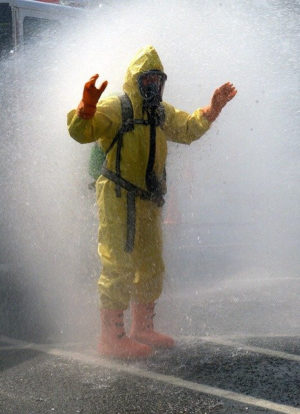Lassa Fever | Healthy Living from Head to Toe
Lassa Fever is one of many hemorrhagic fever viruses that can be devastating to the human body. It is an RNA virus that is part of the Arenavirus Family and is found in the common African Rat, otherwise known as Natal Multimammate. This type of common rat can be found in various countries across the Western Region of Africa. And they often make their way into homes where carriers of the Lassa Fever Virus can infect humans.
Origin of Lassa Fever and Means of Infection
Lassa fever got its name from its point of origin, the Lassa village in Nigeria where it first surfaced in 1969. Unfortunately, this virus has re-surfaced in Nigeria with over 470 cases confirmed and at least 70 deaths.
The virus is communicable through contamination of food and various ways of contact such as, touch, inhalation, scratches, and contact with open cuts and wounds, to name a few of the main routes.
Humans are often infected through coming in contact with the feces and urine of infected rats. But contact with blood, bodily fluids (secreted [sweat, blood] and excreted [feces; urine]), and open wounds and cuts of an infected individual can cause transmission of this virus. Please note that unbroken skin to skin contact is not a direct mean of contracting the Lassa Fever Virus.
What are the Symptoms of Infection with Lassa Virus?
So, as the name implicates, the Lassa Virus causes fever but there are other symptoms that are present as well.
The symptoms can appear within 21 days of infection and can include coughing, difficulty swallowing and breathing, loss of hearing (partial and permanent can occur), abnormal heart rhythms, headache, and slight fever.
The virus can also cause bleeding of the mouth, ears, nose, eyes and other orifices.
Most people are asymptomatic, meaning that the symptoms are not present in them though they are infected.
But, for others the symptoms are evident and sometimes so severe, that it leads to death within a couple of weeks.
How can This Virus Be Detected?
This virus and the symptoms it presents have a lot in common with other hemorragia viruses such as Ebola, thereby, making diagnosis harder without confirmation through specialized laboratory testing.
Using a special test, known as ELISA (enzyme-linked immunosorbent serologic assays), scientist are able to pinpoint the exact virus responsible for the symptoms presented in an infected individual. This type of test detects specific markers that are present in antibodies and antigens when the body is fighting the Lassa Virus.
Is There a Vaccine or Cure?
Unfortunately, the answer is NO. Despite decades since it first surfaced, this RNA virus has yet to be cured. An antiviral drug by the name of Ribavirin, has showed great promise in fighting off this virus, but it comes with its own negative consequences, one being its toxicity. This drug can prove toxic and can result in mutations in the body, which can then result in the possibility of it being harder to fight this virus, as well as, creating other medical issues.
Vaccination against this virus is currently nonexistent, but research and science facilities have some promising discoveries in obtaining a vaccine to help against this infection.
How To Prevent Infection
Prevention is best as with most communicable infections and illnesses.
As with diseases, like the flu, major viral infections like Lassa Fever Virus, Coronaviruses, good personal hygiene is key to prevention. Cover your cough, sneeze, and avoid social contact if you are feeling ill – this can at least help limit the spread to others.
Measures that should be taken by all people, whether infected or not is frequent and thorough hand washing. This is to lessen the likelihood of infection through contact with contaminated objects, i.e. eating without washing hands giving easy entrance of viruses and other microorganisms into the body. Cleaning and disinfecting of common areas, especially food preparation areas is best. Proper storage of foods in containers that prevent access to foods, such a a thick rubbermaid storage container like this or one like this (see below) can greatly reduce the likelihood of rats and other animals chewing through and getting into foods.
For those living in the region affected by the Lassa Virus, keeping areas inside and outside the house clean and clutter free will greatly reduce the possibility of attracting rodents and other animals and insects that are looking for food and hiding places.
Regular removal of trash and proper disposal thereof will also ensure animals such as rats do not make their way in or around your homes, leaving fecal matter wherever they so choose.
Another means of protecting oneself is to wear protective gear like masks, gloves, long sleeves, and protective eyewear. Also, if in contact with the sick, avoid direct contact, i.e. skin contact with bodily fluids and blood of the sick.
Should someone pass on from this infection, proper handling of the body and the use of appropriate hazmat gear is an absolute must.
Proper disinfection of hazmat gear post handling of the dead and or contaminations is also necessary, as well as, the need for sufficient training in how to use and disinfect these gears for medical professionals and those who volunteer to care for the sick.

Summary
Though overshadowed by the Coronavirus, the Lassa Virus is worth making the public aware of. Plus it is good to be aware of the world around you. What goes on at one side of the global can have a trickle down effect on your corner of the global…awareness is vital in today’s day and age (especially so on an international scale). We hope to help those in Nigeria and other West African countries affected form time to time by this virus through raising awareness and providing information that may prove helpful. This like any other viruses out there is best to prevent, rather than have to contain. Therefore, take it upon yourself to be well informed and err on the side of caution …stay healthy.
If you find this or any of our articles informative, then please share and do leave a comment in the comments section, we would like to hear from you.
